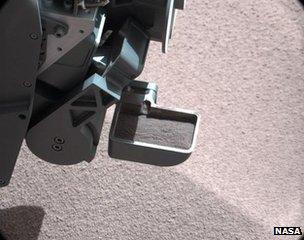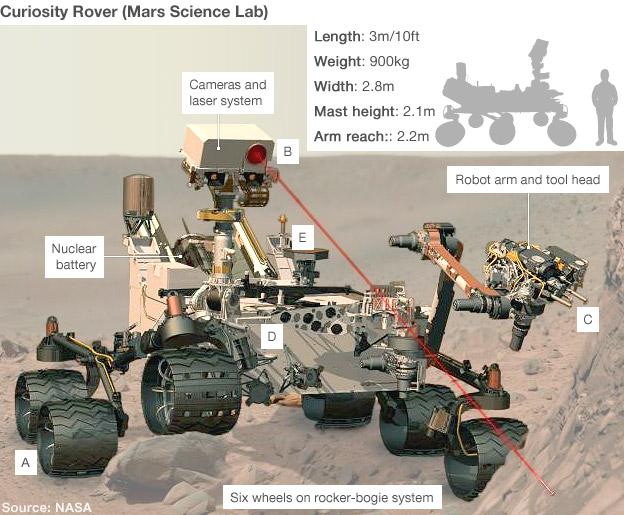Curiosity Mars rover finds soil similar to Hawaii's
- Published

Curiosity's chief scientist said the most important thing about the mobile laboratory is that it eats dirt
Nasa's Curiosity rover has found soil on Mars to be similar to Hawaii's after sifting and scanning its first sample on the Red Planet.
The robot's CheMin instrument, external shook out fine particles of soil and fired X-rays at them to determine their composition.
These sandy samples should give clues about Mars' recent geological history.
As had been theorised, much of the sample is made of weathered "basaltic" materials of volcanic origin, like that seen on the islands of Hawaii.
The sample seems to contain dust carried from afar by Mars' global-scale storms, as well as coarser sand of more local provenance.
The £2.6bn mission put Curiosity on the floor of Gale Crater, a huge depression on Mars' equator, on 6 August.
It has since trundled more than 480m (1,590ft) to the east toward a spot called Glenelg, a place that satellite images indicate is an interesting junction between three different geological terrains.
But it has been paused by the Curiosity team at a region dubbed "Rocknest" to get its first taste of Martian soil.
This first analysis served to "cleanse the palate" of the rover's sample collection systems, which may have brought contaminants from Earth that would skew its chemical view of the Red Planet.
But with that out of the way, Curiosity accomplished another first: the first-ever use of X-ray diffraction on another planet.

Soil samples are first sieved to sequester particles of less than 150 micrometres in size
X-ray diffraction is a well-established approach on Earth, in which a focussed beam of X-rays is either bounced off a sample, giving strong hints both of what kinds of atoms are in a sample and any crystalline structures that they may be locked in.
The CheMin experiment first sieves down a soil sample, separating out the components smaller than 150 micrometres - about the width of two human hairs.
It then gives this sifted soil a shake while firing X-rays at it, examining just how they propagate.
The team says the sample contains "significant amounts" of the minerals feldspar, olivine and pyroxene.
"So far, the materials Curiosity has analysed are consistent with our initial ideas of the deposits in Gale Crater, recording a transition through time from a wet to dry environment," said David Bish, co-investigator on the CheMin experiment.
In the weeks since its arrival on Mars, the rover has already put its ChemCam, external and APXS, external instruments to work examining larger rocks, including a never-before-seen specimen reported earlier in October.
"The ancient rocks, such as the conglomerates, suggest flowing water, while the minerals in the younger soil are consistent with limited interaction with water," said Dr Bish.
The next step was to deliver soil samples into another ground-breaking experiment within the rover – Sam, or the Sample Analysis at Mars instrument, external.
Sam will look for the presence of organic, or carbon-containing, molecules that should give hints about the prospects for life on the Red Planet both now and in the distant past.

(A) Curiosity will trundle around its landing site looking for interesting rock features to study. Its top speed is about 4cm/s
(B) This mission has 17 cameras. They will identify particular targets, and a laser will zap those rocks to probe their chemistry
(C) If the signal is significant, Curiosity will swing over instruments on its arm for close-up investigation. These include a microscope
(D) Samples drilled from rock, or scooped from the soil, can be delivered to two hi-tech analysis labs inside the rover body
(E) The results are sent to Earth through antennas on the rover deck. Return commands tell the rover where it should drive next
- Published19 October 2012
- Published17 October 2012
- Published12 October 2012
- Published5 October 2012
- Published27 September 2012
- Published22 September 2012
- Published21 September 2012
- Published18 September 2012
- Published20 August 2012
- Published17 August 2012
- Published9 August 2012
- Published6 August 2012
- Published4 August 2012